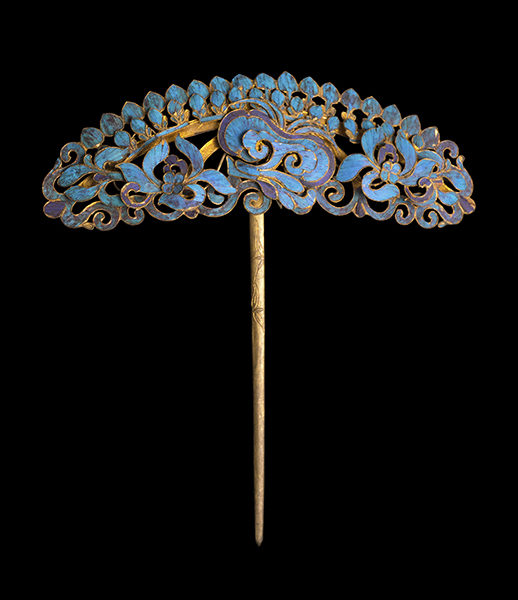
Kingfisher Hair Ornament
Anonymous, China, 19th c.
Feathers on copper
5 1/2 in. x 5 in.
Scripps College, Claremont, CA
This hairpin, with its vibrant blue hue, is no doubt exquisite to behold. Its significance lies in more than just the aesthetic pleasure it brings, though—it reveals another avenue with which to explore historic Chinese society. However, it also acts as a chilling reminder of what people are willing to ignore when tempted by beauty.
Made in the 19th century and consisting of copper inlaid with kingfisher feathers, the decorative elements of the hairpin rely substantially on floral imagery and its significance. What may be orchids composes the majority of the headpiece, while more flowers are engraved along its lower portion. Used in a number of arts and writing, the orchid—an encapsulation of spring—is one of the most important flowers in Chinese symbolism and is said to represent nobility, integrity, and friendship (Chinese Flowers and Their Meanings). It has also been used to describe a woman’s beauty, determine the traits of a perfect man, and embody the spirit of philosopher Confucius (Koehn 132, Flower and Fruit Symbolism in Chinese Art 花朵 Huā Duǒ). At the top edge of the hairpiece, budding flowers seem to sprout in two rows, further epitomizing spring and the beginning of new life. Taken together, these floral motifs create a visual message that many would want to be associated with.
Coupled with this imagery, the hairpin’s form also allows for a deeper understanding of Chinese society. Although hairpins were used by all genders, this hairpin, known as a buyao (or “shake as you step” since it quivered when worn), most likely belonged to a wealthier woman. An object that could attract the wearer’s romantic or sexual partners when manipulated deftly, a buyao had erotic power that was commonly linked to women’s dress and demeanor (Jackson 133). Additionally, the use of kingfisher feathers alludes to the affluence of the wearer. Hairpins and most jewelry did not symbolize wealth or act as status objects; instead, they were considered to be egalitarian items that anyone could wear (130). However, as far back as the 8th century BCE in China, jewelry containing kingfisher feathers was deemed particularly valuable due to its brilliant coloring and rarity (28, 46). Through its color, motion, and material, the hairpin resulted in a visually enticing object that many would have wanted to possess.
However, the hairpin’s beauty is complicated by its creation, which is rooted in suffering. The kingfisher feathers are most commonly found on white-breasted kingfishers (Halcyon smyrnensis), which were often taken from Cambodia as these birds were considered to be of the highest quality (Jackson 5). Armand David, a French zoologist who made frequent visits to China in the 1800s, found that 19th-century kingfisher traders would snare the birds and strip them of their blue feathers before releasing them back into the wild (David 72-73). This method was actually deemed more “optimistic” for the birds when compared to previous centuries when the birds were slaughtered outright (Jackson 3). The tortuous creation process did not end with the birds though, for working with the feathers was also difficult. As the birds’ feathers were considered precious by Chinese society, artisans who created kingfisher jewelry had to be precise when cutting and gluing the delicate feathers onto metal frames—a precision that caused many makers to go blind later on in life (50).
Production of kingfisher jewelry—and the cruel acts associated with it—ended in the 1940s in an attempt to protect the kingfisher population. However, the delicate jewelry and art can still be found in many galleries, museums, and private collections in Europe and America, including that of Scripps College (von Ferscht). This hairpin, and other kingfisher pieces that are part of the collection at Scripps, stand as testament to the seduction of beauty, and the pain it can leave in its wake.
Aubrey Beam, Getty Multicultural Intern 2018, Stanford University ’18
Photo by Jan Blair
Works Cited
“Chinese Flowers and Their Meanings.” Flower Meaning, 2017, www.flowermeaning.com/chinese-flower-meanings/.
David, Armand, et al. Les Oiseaux De La Chine. G. Masson, 1877.
“Flower and Fruit Symbolism in Chinese Art 花朵 Huā Duǒ.” Chinasage, 25 Jan. 2018, www.chinasage.info/symbols/flowersandfruit.htm.
Jackson, Beverley. Kingfisher Blue: Treasures of an Ancient Chinese Art. Ten Speed Press, 2001.
Koehn, Alfred. “Chinese Flower Symbolism.” Monumenta Nipponica, vol. 8, no. 1/2, 1952, pp. 121-146. JSTOR, JSTOR, www.jstor.org/stable/2383008.
von Ferscht, Adrien. “Chinese Blues: The Ancient Art of Tian Tsui.” Vastari Blog, Vastari Blog, 9 Oct. 2013, blog.vastari.com/chinese-blues–the-ancient-art-of-tian-tsui/.

